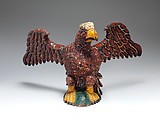Eagle
Wilhelm Schimmel American
Not on view
The surviving body of brightly painted carved birds and animals attributed to the German émigré artist Wilhelm Schimmel represents one of the best known groups of American folk carving. Schimmel arrived about 1860 in Pennsylvania’s Cumberland Valley and found support within the close-knit community of German and Scotch-Irish farmers, who purchased or traded food and lodging for his work. Using a common folding pocket knife, Schimmel carved deep, angular cuts to articulate his eagle, then applied a white primer and common house paints. His student Aaron Mountz would continue this carving tradition into the early twentieth century.
Due to rights restrictions, this image cannot be enlarged, viewed at full screen, or downloaded.
This artwork is meant to be viewed from right to left. Scroll left to view more.



